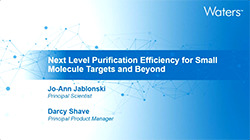

HPLC purification is powerful and its purpose practical:
- Recover the target compound
- Obtain desired target purity and yield
- Complete the purification in the least amount of time
“Sticky” compounds seemingly hang up in the preparative column and are difficult to effectively detect and collect. When this occurs, prep separations degrade, and the target’s purification success is at risk. In particular, metal-sensitive targets can adsorb to positively charged metal surfaces in the flow path and column. These non-specific adsorbers (NSAs) behave unpredictably and can lead to sample loss, compromised purity or low throughput. Learn how to overcome these issues in LC purifications and improve productivity with a new OBD preparative column technology that is inert to analytes that may be prone to non-specific binding.
- What types of compounds can be NSAs
- What are the chromatographic issues NSAs exhibit and the impact they have on compound purification
- How to mitigate NSA challenges with inert preparative columns
- How to safeguard your purifications even when isolating compounds with unknown structures which may be non-specific adsorbers
- How improving sensitivity can significantly improve outcomes from batch library purifications or for other samples where first-time injection success is paramount to retrieve even low-level targets

Copyright © 2025 American Chemical Society | 1155 Sixteenth Street NW | Washington, DC 20036 | View our Privacy Policy